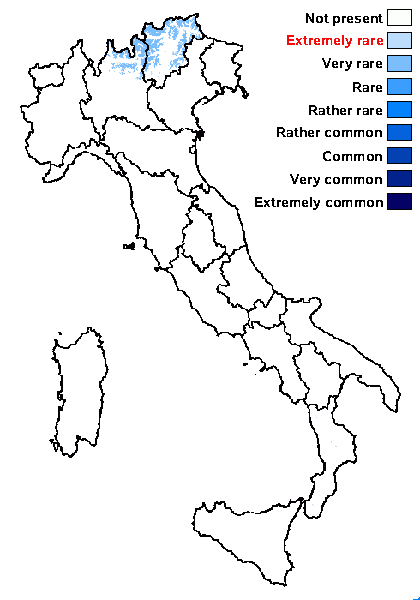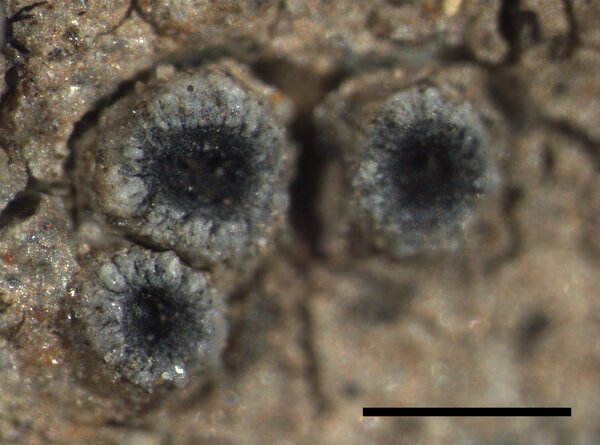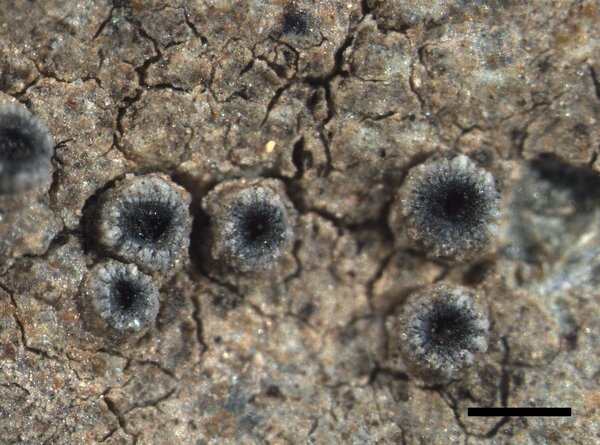Gyalidea fritzei (Stein) Vězda
Folia Geobot. Phytotaxon., 1: 324, 1966. Basionym: Gyalecta fritzei Stein in Cohn - Kryptogamenfl. von Schlesien, 2, 2: 154, 1879.
Synonyms:
Distribution: N - TAA (Nascimbene & al. 2021), Lomb (Nascimbene 2006). S - Cal (Puntillo 2011).
Description: Thallus crustose, endosubstratic or thinly episubstratic, continuous or rarely rimose, white to rusty red, often poorly evident and reduced to a collar around the apothecia. Apothecia 0.2-0.6 mm across, sessile, urceolate and almost perithecioid when young, with a concave, pale orange to dark brown disc, and a rather thick, brown to brown-black, sometimes fissured proper margin. Proper exciple 30-40 µm wide at base, c.100 µm wide laterally, dark brown in outer part, colourless within; epithecium pale brown; hymenium colourless or pale brown in upper part, (80-)100-120(-160) μm high; paraphyses mostly simple, 0.8-1.5 µm thick, embedded in a gelatinous matrix; hypothecium very pale brown. Asci 6-8-spored, clavate, thin-walled except for a slightly thickened apical tholus, K/I-, 76-120 x 25-45 µm. Ascospores muriform, with 5-7 transverse septa and 2-3 longitudinal septa, hyaline, broadly ellipsoid to subglobose, (18-)24-35(-43) x (10-)12-16(-21) μm, sometimes attenuated at one end. Photobiont chlorococcoid, the cells 7-17 μm wide. Spot tests: thallus K-, C-, KC-, P-, UV-. Chemistry: without lichen substances.Note: on siliceous rocks in humid-shaded habitats, such as along creeks, with optimum above treeline; to be looked for further in the Alps, but certainly not common.
Growth form: Crustose
Substrata: rocks
Photobiont: green algae other than Trentepohlia
Reproductive strategy: mainly sexual
Commonnes-rarity: (info)
Alpine belt: very rare
Subalpine belt: extremely rare
Oromediterranean belt: extremely rare
Montane belt: absent
Submediterranean belt: absent
Padanian area: absent
Humid submediterranean belt: absent
Humid mediterranean belt: absent
Dry mediterranean belt: absent

Predictive model
Herbarium samples
Growth form: Crustose
Substrata: rocks
Photobiont: green algae other than Trentepohlia
Reproductive strategy: mainly sexual
Commonnes-rarity: (info)
Alpine belt: very rare
Subalpine belt: extremely rare
Oromediterranean belt: extremely rare
Montane belt: absent
Submediterranean belt: absent
Padanian area: absent
Humid submediterranean belt: absent
Humid mediterranean belt: absent
Dry mediterranean belt: absent

Predictive model
| Herbarium samples |
 INDEX FUNGORUM
INDEX FUNGORUM
 GBIF
GBIF
 DOLICHENS
DOLICHENS





